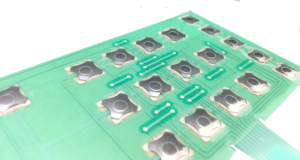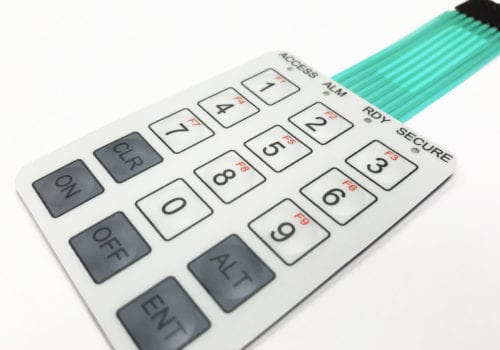Secret Benefits of Using a Membrane Switch in Industrial Applications
Secret Benefits of Using a Membrane Switch in Industrial Applications
Blog Article
How Membrane Switches Contribute to the Longevity of Electronic Control Panels
Membrane layer buttons play a crucial function in improving the durability of electronic control panels, mostly with their multi-layered building and construction which gives efficient defense against ecological aspects such as wetness and dust. The lack of relocating components dramatically lowers the probability of mechanical failings, making membrane layer switches over ideal for demanding applications.
Definition of Membrane Buttons

Membrane buttons are made to be slim and lightweight, making them ideal for applications where area is limited. They can be made in different forms, sizes, and shades, using flexibility in style that meets aesthetic and useful needs. Additionally, membrane switches can integrate numerous technologies, such as responsive feedback and LED indicators, enhancing customer experience.
As a result of their construction, membrane layer buttons are commonly immune to dirt, dampness, and basic wear, adding to their longevity sought after settings. Their seamless layout not just assists in very easy cleaning however additionally lessens the danger of mechanical failure, making them a favored option for suppliers looking for reputable customer interfaces in their digital control panels.
Defense Versus Environmental Factors
The style of membrane layer switches over naturally supplies a degree of defense versus numerous ecological variables, which is important for maintaining performance in tough conditions - Membrane Switch. These buttons are generally constructed with layers of versatile products that shield interior components from wetness, dust, and impurities. By encapsulating the circuitry, membrane layer switches over minimize the threat of short circuits and rust, which can considerably impair performance
Additionally, using durable adhesives and sealers throughout production boosts their resistance to environmental obstacles. Membrane switches can withstand direct exposure to chemicals and solvents, making them appropriate for industries such as food handling and medical care, where health and cleanliness are critical. Their smooth surface design likewise avoids the build-up of dust and bacteria, assisting in much easier cleaning and upkeep.
Temperature changes are another ecological problem, and membrane switches are crafted to work effectively across a variety of temperatures (Membrane Switch). This flexibility makes sure that control panels remain operational in different setups, from commercial atmospheres to consumer electronics
Effect On Individual Interaction
User communication with electronic control board is substantially influenced by the layout and performance of membrane buttons. These buttons offer a responsive user interface that boosts the overall user experience, enabling instinctive navigating and control. Their receptive nature makes sure that individuals get prompt feedback upon activation, which is critical for jobs requiring accuracy and effectiveness.
Furthermore, the smooth surface area of membrane switches over promotes easy cleansing and maintenance, promoting user confidence in the dependability of the interface. This cleanliness is especially vital in settings where hygiene is paramount, such as medical or food processing setups. Furthermore, the compact and lightweight design of membrane switches over adds to the visual allure of control board, urging customer engagement try this site through a contemporary and streamlined look.
Additionally, the integration of aesthetic elements, such as printed symbols and backlighting, aids customers quickly recognize features, reducing the discovering curve related to brand-new devices. Therefore, users can operate gadgets better, bring about increased efficiency and satisfaction. In summary, membrane switches play an essential function in improving individual interaction by integrating performance, aesthetic appeals, and simplicity of use, inevitably resulting in improved functional performance.
Style Adaptability and Customization
Design versatility and modification are important elements of membrane layer buttons, making it possible for producers to tailor electronic control panels to particular applications and individual requirements. This adaptability permits the combination of different layout components, such as colors, graphics, and appearances, which can boost the aesthetic appeal and individual interaction of the control board.
Membrane layer buttons can be tailored in shapes and size, fitting a broad variety of devices and applications, from industrial equipment to customer electronics. This adaptability ensures that makers can produce instinctive user interfaces that line up with individual expectations and operational requirements. In addition, the capability to incorporate special attributes such as backlighting or tactile responses even more boosts use, allowing for an extra interactive experience.
Moreover, the manufacturing procedure for membrane switches over sustains the rapid prototyping of styles, making it possible for makers to iterate and improve their concepts swiftly. This ability not only accelerates the advancement timeline but likewise ensures that the end product fulfills certain practical and aesthetic standards.

Cost-Effectiveness and Longevity
Cost-effectiveness and durability are considerable benefits of membrane layer buttons, making them an appealing option for suppliers and end-users alike. These buttons are typically much less pricey to create than standard mechanical link switches, mainly because of their streamlined manufacturing processes and the reduced variety of elements called for. This cost benefit extends not just to initial production yet additionally to lasting operational expenditures, as membrane layer buttons often require much less upkeep and have a reduced failure rate.
Furthermore, the longevity of membrane layer switches adds to their general worth. Created from resilient materials, they are immune to environmental aspects such as moisture, dirt, and chemicals, which can bring about premature wear in other button types. The lack of relocating components reduces mechanical failure, enabling membrane layer switches to maintain functionality over prolonged click reference periods.
This sturdiness is specifically advantageous in applications calling for regular efficiency under requiring conditions, such as clinical tools and industrial equipment. Inevitably, the mix of cost-effectiveness and longevity makes membrane switches over an economically viable choice for makers, offering trustworthy services that withstand the test of time while optimizing budgetary considerations.
Verdict
In final thought, membrane layer buttons dramatically enhance the resilience of digital control board via their durable construction and safety functions. By efficiently securing circuitry from ecological hazards and minimizing the risk of mechanical failing, these switches guarantee consistent efficiency sought after applications. The seamless style promotes hygiene and simplicity of upkeep, while personalization choices make it possible for tailored options for various needs. On the whole, membrane switches over represent a reputable and economical option for enhancing the longevity and performance of digital control systems.
Report this page